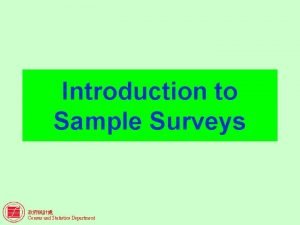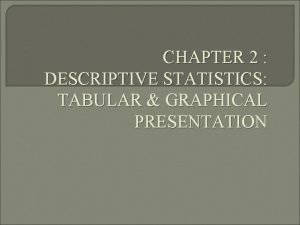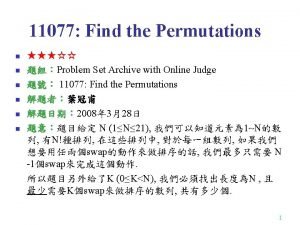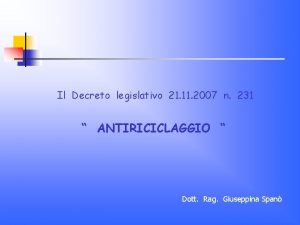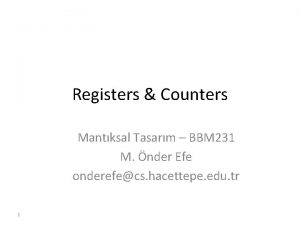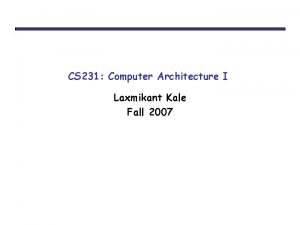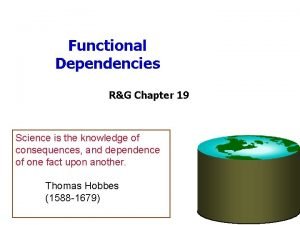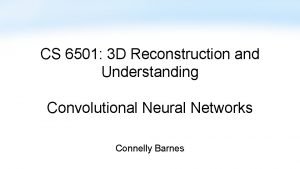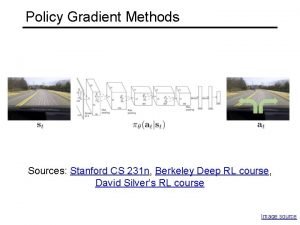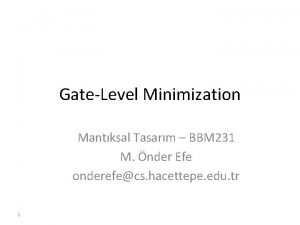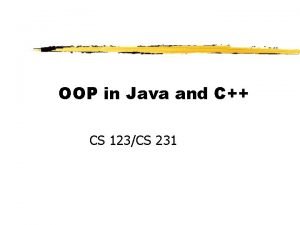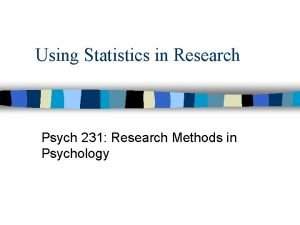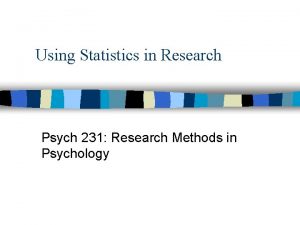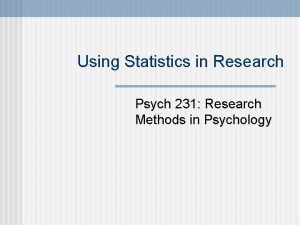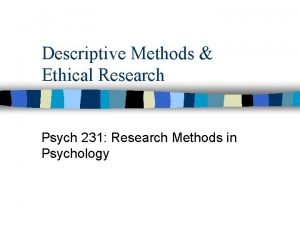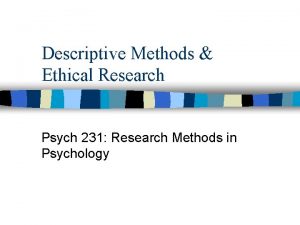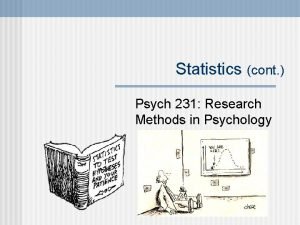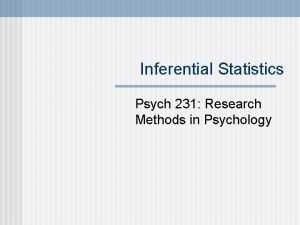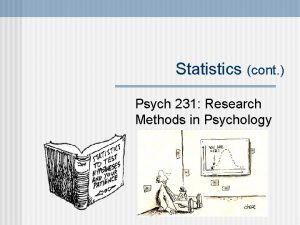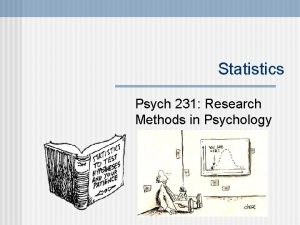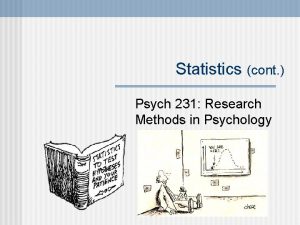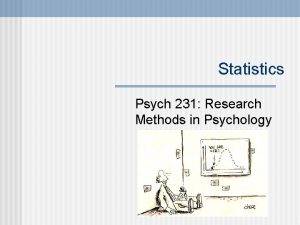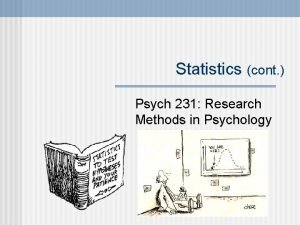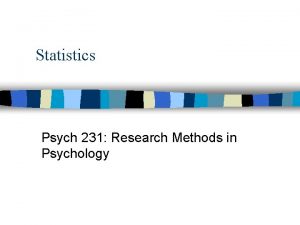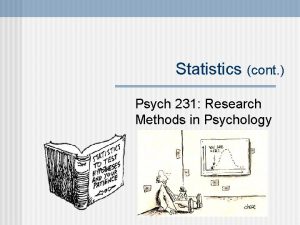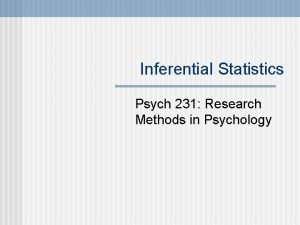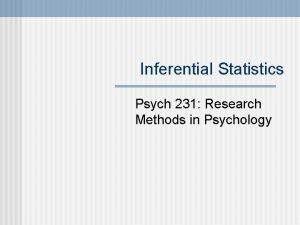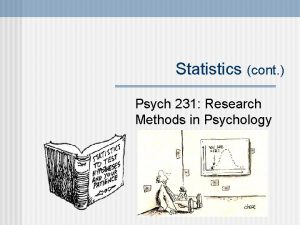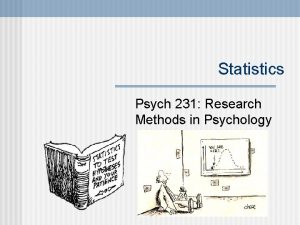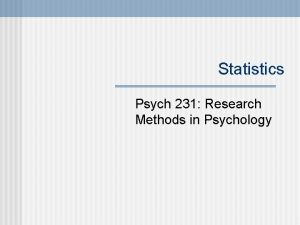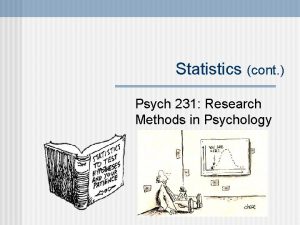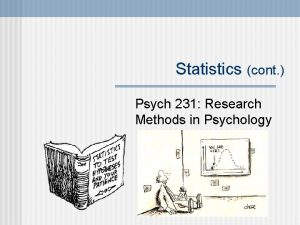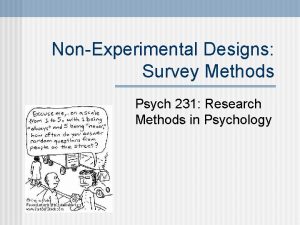Using Statistics in Research Psych 231 Research Methods
























- Slides: 24

Using Statistics in Research Psych 231: Research Methods in Psychology

From Correlation to Regression n Last time we “imagined” a line through the points Y 6 5 4 3 2 1 1 2 3 4 5 6 X

From Correlation to Regression n Compute the equation for the line that best fits the data points Y 6 5 Y = (X)(slope) + (intercept) 4 3 2 1 0. 5 Change in Y 1 2 3 4 5 6 X Change in X 2. 0 = slope

Regression n 4. 5 Can make specific predictions about Y based on X Y 6 5 X=5 Y = (X)(. 5) + (2. 0) Y=? Y = (5)(. 5) + (2. 0) Y = 2. 5 + 2 = 4. 5 4 3 2 1 1 2 3 4 5 6 X

Regression n Also need a measure of error Y = X(. 5) + (2. 0) + error • Same line, but different relationships (strength difference) Y 6 5 4 3 2 1 1 2 3 4 5 6 X

Cautions with correlation & regression n Don’t make causal claims Don’t extrapolate Extreme scores (outliers) can strongly influence the calculated relationship

Inferential Statistics n Purpose: To make claims about populations based on data collected from samples n Ø What’s the big deal? Example Experiment: Ø Group A - gets treatment to improve memory Ø Group B - gets no treatment (control) Ø Ø After treatment period test both groups for memory Results: Ø Group A’s average memory score is 80% Ø Group B’s is 76% Ø Is the 4% difference a “real” difference (statistically significant) or is it just sampling error?

Testing Hypotheses n n n Step 1: State your hypotheses Step 2: Set your decision criteria Step 3: Collect your data from your sample(s) Step 4: Compute your test statistics Step 5: Make a decision about your null hypothesis n n “Reject H 0” “Fail to reject H 0”

Testing Hypotheses n Step 1: State your hypotheses n Null hypothesis (H 0) • “There are no differences (effects)” n Alternative hypothesis(ses) This is the hypothesis that you are testing • Generally, “not all groups are equal” n You aren’t out to prove the alternative hypothesis (although it feels like this is what you want to do) n If you reject the null hypothesis, then you’re left with support for the alternative(s) (NOT proof!)

Testing Hypotheses n Step 1: State your hypotheses Ø In our memory example experiment Ø Ø Null H 0: mean of Group A = mean of Group B Alternative HA: mean of Group A ≠ mean of Group B Ø (Or more precisely: Group A > Group B) Ø Ø Ø It seems like our theory is that the treatment should improve memory. That’s the alternative hypothesis. That’s NOT the one the we’ll test with inferential statistics. Instead, we test the H 0

Testing Hypotheses n n Step 1: State your hypotheses Step 2: Set your decision criteria n Your alpha level will be your guide for when to: • “reject the null hypothesis” • “fail to reject the null hypothesis” n This could be correct conclusion or the incorrect conclusion • Two different ways to go wrong • Type I error: saying that there is a difference when there really isn’t one (probability of making this error is “alpha level”) • Type II error: saying that there is not a difference when there really is one

Error types Real world (‘truth’) H 0 is correct Reject H 0 Experimenter’s conclusions Fail to Reject H 0 is wrong Type I error Type II error

Error types: Courtroom analogy Real world (‘truth’) Defendant is innocent Defendant is guilty Type I error Jury’s decision Find guilty Find not guilty Type II error

Error types n Type I error: concluding that there is an effect (a difference between groups) when there really isn’t. n n n Sometimes called “significance level” We try to minimize this (keep it low) Pick a low level of alpha Psychology: 0. 05 and 0. 01 most common Type II error: concluding that there isn’t an effect, when there really is. n n Related to the Statistical Power of a test How likely are you able to detect a difference if it is there

Testing Hypotheses n n Step 1: State your hypotheses Step 2: Set your decision criteria Step 3: Collect your data from your sample(s) Step 4: Compute your test statistics n n n Descriptive statistics (means, standard deviations, etc. ) Inferential statistics (t-tests, ANOVAs, etc. ) Step 5: Make a decision about your null hypothesis n n Reject H 0 Fail to reject H 0 “statistically significant differences” “not statistically significant differences”

Statistical significance n “Statistically significant differences” n When you “reject your null hypothesis” • Essentially this means that the observed difference is above what you’d expect by chance • “Chance” is determined by estimating how much sampling error there is • Factors affecting “chance” • Sample size • Population variability

Sampling error Population mean Population Distribution x n=1 Sampling error (Pop mean - sample mean)

Sampling error Population mean Population Distribution Sample mean x n=2 x Sampling error (Pop mean - sample mean)

Sampling error § Generally, as mean the sample Population size increases, the sampling error decreases Sample mean Population Distribution x x n = 10 x x x xx Sampling error (Pop mean - sample mean)

Sampling error n Typically the narrower the population distribution, the narrower the range of possible samples, and the smaller the “chance” Small population variability Large population variability

Sampling error n These two factors combine to impact the distribution of sample means. n The distribution of sample means is a distribution of all possible sample means of a particular sample size that can be drawn from the population Population Distribution of sample means Samples of size = n XA XB XC XD “chance” Avg. Sampling error

Significance n “A statistically significant difference” means: n n n the researcher is concluding that there is a difference above and beyond chance with the probability of making a type I error at 5% (assuming an alpha level = 0. 05) Note “statistical significance” is not the same thing as theoretical significance. n n Only means that there is a statistical difference Doesn’t mean that it is an important difference

Non-Significance n Failing to reject the null hypothesis n n Generally, not interested in “accepting the null hypothesis” (remember we can’t prove things only disprove them) Usually check to see if you made a Type II error (failed to detect a difference that is really there) • Check the statistical power of your test • Sample size is too small • Effects that you’re looking for are really small • Check your controls, maybe too much variability

Next time: Inferential Statistical Tests n Different statistical tests n n n “Generic test” T-test Analysis of Variance (ANOVA)
 Introduction to statistics what is statistics
Introduction to statistics what is statistics Descriptive statistics numerical measures
Descriptive statistics numerical measures Sampling methods statistics
Sampling methods statistics Tabular and graphical presentation of data
Tabular and graphical presentation of data Indirect methods of contoring uses how many methods
Indirect methods of contoring uses how many methods Acf 231
Acf 231 Article 231 of the treaty of versailles
Article 231 of the treaty of versailles 132 213
132 213 Pa msu
Pa msu D lgs 231/2007
D lgs 231/2007 Hino 231
Hino 231 Gezang 231
Gezang 231 Ring counter verilog
Ring counter verilog Transitor
Transitor Cost 231 walfisch-ikegami model
Cost 231 walfisch-ikegami model Draw 231 with base ten blocks
Draw 231 with base ten blocks 040 231 3666
040 231 3666 Mvcnn pytorch
Mvcnn pytorch Cs 231 n
Cs 231 n Bbm 231
Bbm 231 Pengertian berjiran
Pengertian berjiran German territorial losses ww1
German territorial losses ww1 Java 231
Java 231 Club-231
Club-231 Electric potential energy definition
Electric potential energy definition


